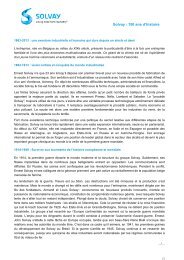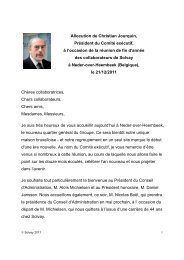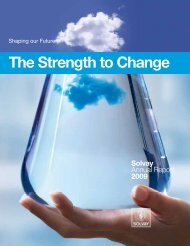solvay_live243_p02a04 somEdito
solvay_live243_p02a04 somEdito
solvay_live243_p02a04 somEdito
Create successful ePaper yourself
Turn your PDF publications into a flip-book with our unique Google optimized e-Paper software.
A<br />
and succinct: everything relating to the problem and the solution<br />
should be able to be described on one A3 size of paper!<br />
Respect and egalitarianism is just another example of how Toyota<br />
works. There are no ‘corner’ offices for managers, and everybody<br />
is invited to have their say. Each and every opinion is valued, and<br />
appreciated. Listening – a trait that anybody who has worked with<br />
Japanese will know well – is encouraged and rewarded.<br />
“Toyota is a way of life, and not a 9-to-5 type of company”, Colin<br />
Hensley explains. “The people who work here love their jobs. It is not<br />
unusual to find the engineers working on cars and engines during<br />
the weekend: it is their passion, and their hobby. And Toyota respects<br />
this. ‘Genchi genbutsu’ means ‘go and see for yourself to thoroughly<br />
understand the situation’ – it is clear we trust and respect the talents<br />
of our people to deliver better solutions when confronted with<br />
the reality on the ground.”<br />
Working with suppliers<br />
Toyota believes in success. And they know that they can help<br />
their supplier be successful by working with them, rather than<br />
against them. Again, honest principles apply to the way they<br />
work with their suppliers: trust, understanding and respect.<br />
Absolutely, cost is an issue, but together with the supplier’s<br />
team, all efforts are made to work towards a common goal,<br />
rather than working at cross purposes. Toyota knows that<br />
if a supplier does well, they’ll both do well. And that goes<br />
for customers too – as Toyota constantly leads the reliability<br />
and longevity charts in Europe. No mean feat. No mean<br />
company. •<br />
Performance improvement<br />
The Toyota Principles (*)<br />
14 key points are grouped<br />
under four main principles:<br />
Long term philosophy<br />
1. Base your management decisions on a long-term<br />
philosophy, even at the expense of short-term goals.<br />
The right process will produce the right results<br />
2. Create a continuous process flow<br />
to bring problems to the surface.<br />
3. Use “pull” systems to avoid overproduction.<br />
4. Level out the workload (heijunka). (Work like<br />
the tortoise, not the hare)<br />
5. Build a culture of stopping to fix problems,<br />
to get quality right the first time.<br />
6. Standardised tasks are the foundation for continuous<br />
improvement and employee empowerment.<br />
7. Use visual control so that no problems<br />
are hidden.<br />
8. Use only reliable, thoroughly tested technology that<br />
serves your people and processes. .<br />
Add value to the Organisation<br />
by developing your people<br />
9. Grow leaders who thoroughly understand the work,<br />
live the philosophy and teach it to others.<br />
10. Develop exceptional people and teams who follow<br />
your company’s philosophies.<br />
11. Respect your extended network of partners<br />
and suppliers by challenging them and helping<br />
them to improve.<br />
Continuously solving root problems drives<br />
organizational learning<br />
12. Go and see for yourself to thoroughly understand<br />
the situation (genchi genbutsu).<br />
13. Make decisions slowly by consensus, thoroughly<br />
considering all options; implement decisions<br />
rapidly (nemawashi).<br />
14. Become a learning organization through<br />
relentless reflection (hansei) and continuous<br />
improvement (kaizen).<br />
(*) Source: “The Toyota way - 14 Management Principles<br />
from the world's greatest manufacturer” - Jeffrey K. Liker<br />
J U L Y 2 0 0 6<br />
43


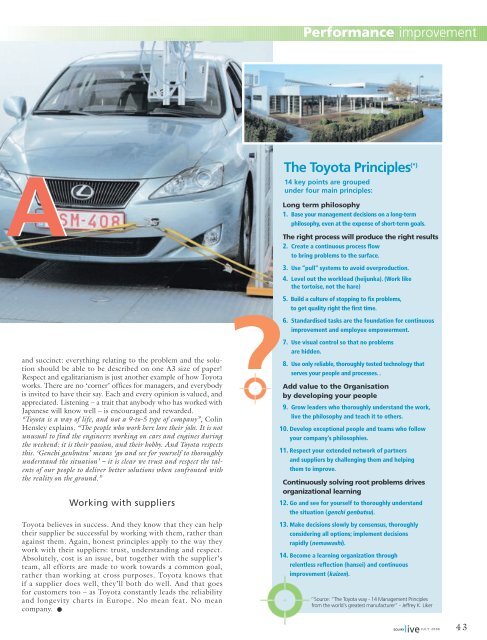

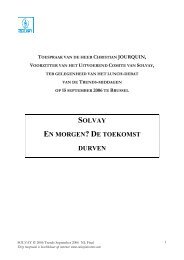
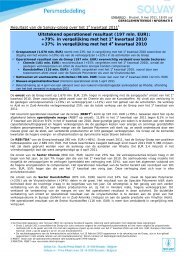

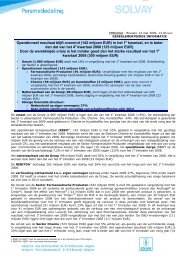
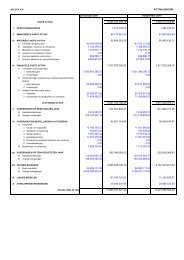

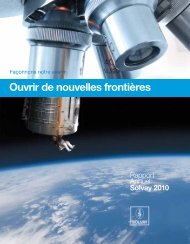
![PROC.1 [LETTRE] - Solvay](https://img.yumpu.com/16585746/1/184x260/proc1-lettre-solvay.jpg?quality=85)
